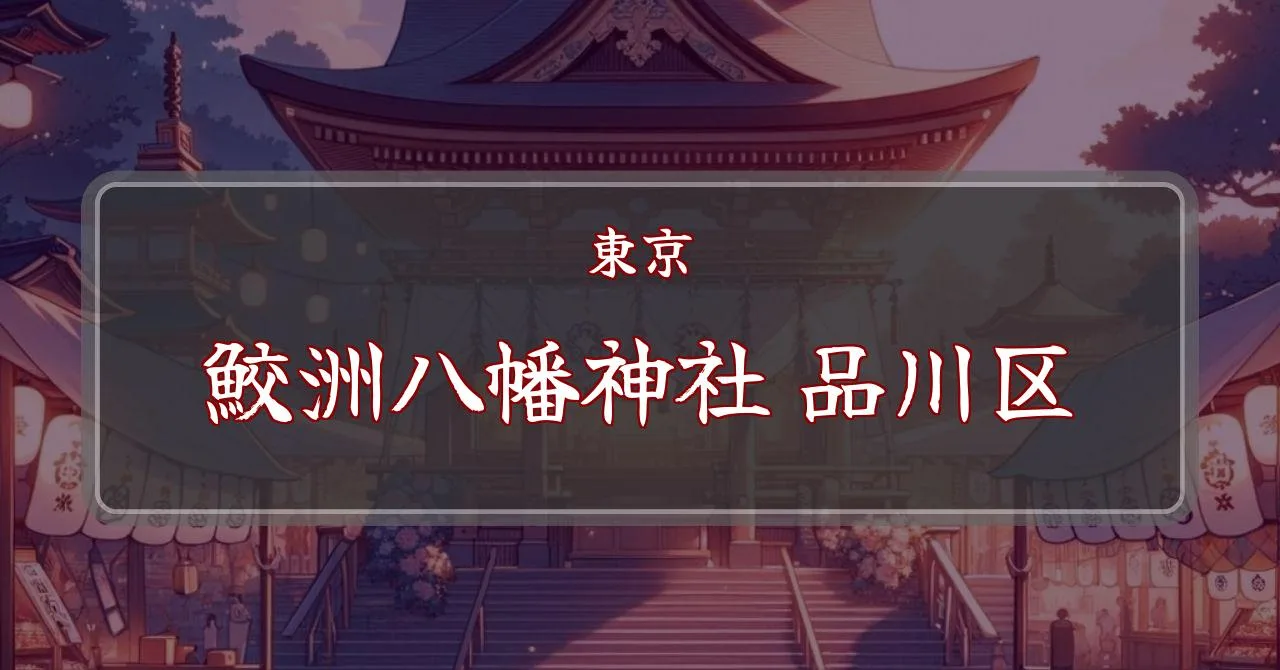鮫洲八幡神社例大祭2025:深夜の神輿渡御!品川区の夏の夜を彩る
イベントの概要
東京都品川区東大井にある鮫洲八幡神社の例大祭は、2025年も夏の夜を熱狂で彩ります! 最大の見どころは、なんといっても深夜に行われる大神輿の宮出し! 午前2時過ぎから響き渡る「よせの太鼓」の大拍子に合わせ、午前2時半よりみたま移し式、午前3時より宮出しが始まり、約4時間に渡り、朝7時まで御旅所まで担がれます。 神輿は前後合わせて6本の横棒を担ぎ、笛と大拍子のリズムにのって渡御されます。神社の鳥居が低く狭いことから、宮出しと宮納めの際には専用の短い担ぎ棒と交換し、神輿を担がずに横棒を抱えて鳥居をくぐります。この独特の光景は、鮫洲八幡神社例大祭ならではの迫力と伝統を感じさせてくれます。 2024年の例大祭では、8月15日(木)~18日(日)の4日間開催され、15日は神社総代のみで例大祭式典が行われました。 2025年の具体的な日程や、子供神輿、山車などの詳細情報は、鮫洲八幡神社の公式ホームページやSNSで確認できますので、ぜひチェックしてみてください。 深夜の幻想的な神輿渡御、そして伝統と活気に満ちた祭りを、ぜひ体感しに鮫洲八幡神社へお越しください!
基本情報
- 開催日: 2025年8月15日(金)~18日(月) ※8月15日は例大祭式典を神社総代のみで執り行います。
- 開催時間: 大神輿宮出し:8月17日(土) 午前3時頃~午前7時頃 大神輿宮納め:8月18日(日) 午後3時頃~午後6時頃 ※その他神事や子供神輿、山車などの時間は、鮫洲八幡神社の公式ホームページ等でご確認ください。
- 住所・開催場所: 鮫洲八幡神社
東京都品川区東大井1-20-10 - アクセス: 京急本線 鮫洲駅 徒歩1分
主なイベント
鮫洲八幡神社例大祭のハイライトは、なんといっても深夜に行われる大神輿の渡御です。 この迫力ある神事と、地域住民の熱気に満ちた祭りの雰囲気は、他の祭りでは味わえない独特の体験となるでしょう。 その他にも、子供神輿や山車など、地域全体が一体となって盛り上げる様々な催し物が開催されます。 公式ホームページ等で詳細なスケジュールを確認し、お好みのイベントに参加してみてはいかがでしょうか。
大神輿渡御
鮫洲八幡神社例大祭の最大の見どころは、深夜に行われる大神輿の宮出しです。 8月17日(土)の午前2時を過ぎると、大拍子「よせの太鼓」が鳴り響き、2時半よりみたま移し式、3時より宮出しが始まります。 約4時間かけて、朝7時頃まで御旅所まで担がれます。 神輿は前後合わせて6本の横棒を担ぎ、笛と大拍子にあわせて渡御されます。 神社の鳥居が低く狭いため、宮出しと宮納めの際には専用の短い担ぎ棒と交換し、神輿を担がずに横棒を抱えて鳥居をくぐります。この独特の光景は、鮫洲八幡神社例大祭ならではの迫力と伝統を感じさせてくれます。 翌18日(日)午後3時からは宮納めが行われ、午後6時頃には神社へ帰社します。
- 日時:8月17日(土) 午前3時頃~午前7時頃(宮出し)、8月18日(日) 午後3時頃~午後6時頃(宮納め)
- 特徴:深夜の宮出し、6本の横棒、狭い鳥居をくぐる独特の担ぎ方
- 見どころ:幻想的な雰囲気の深夜の神輿渡御、地域住民の熱気、伝統的な神事
子供神輿・山車
例大祭では、各町会から子供神輿や山車も参加し、祭りを盛り上げます。 子供たちの元気な姿と、地域住民の温かい雰囲気は、祭りの魅力の一つです。 具体的な時間やルートなどは、鮫洲八幡神社の公式ホームページや、地元の広報誌などで確認してください。
- 内容:各町会による子供神輿と山車の巡行
- 時期:例大祭期間中
- 詳細:鮫洲八幡神社公式ホームページ等で確認
その他イベント
上記以外にも、例大祭期間中には様々なイベントが開催される可能性があります。 屋台の出店や、地域住民による催し物など、祭りをさらに盛り上げる企画が予定されているかもしれません。 最新の情報は、鮫洲八幡神社の公式ホームページやSNSなどでご確認ください。
- 内容:屋台の出店、地域住民による催し物など
- 詳細:鮫洲八幡神社公式ホームページ等で確認
アクセス方法
鮫洲八幡神社例大祭は、アクセス抜群の好立地で開催されます。最寄りの京急本線鮫洲駅から徒歩わずか1分!駅から神社までは、平坦な道を歩くだけで簡単に到着できます。電車でのアクセスが非常に便利なので、遠方から来場される方も安心してご参加いただけます。 お車でお越しの際は、近隣の有料駐車場をご利用ください。 公共交通機関をご利用いただくことをお勧めします。
- 電車:京急本線鮫洲駅より徒歩1分
駐車場情報
鮫洲八幡神社には駐車場がありません。お車でお越しの際は、近隣の有料駐車場をご利用ください。 例大祭期間中は特に混雑が予想されますので、公共交通機関の利用を強くお勧めします。
- 近隣のコインパーキングをご利用ください。



